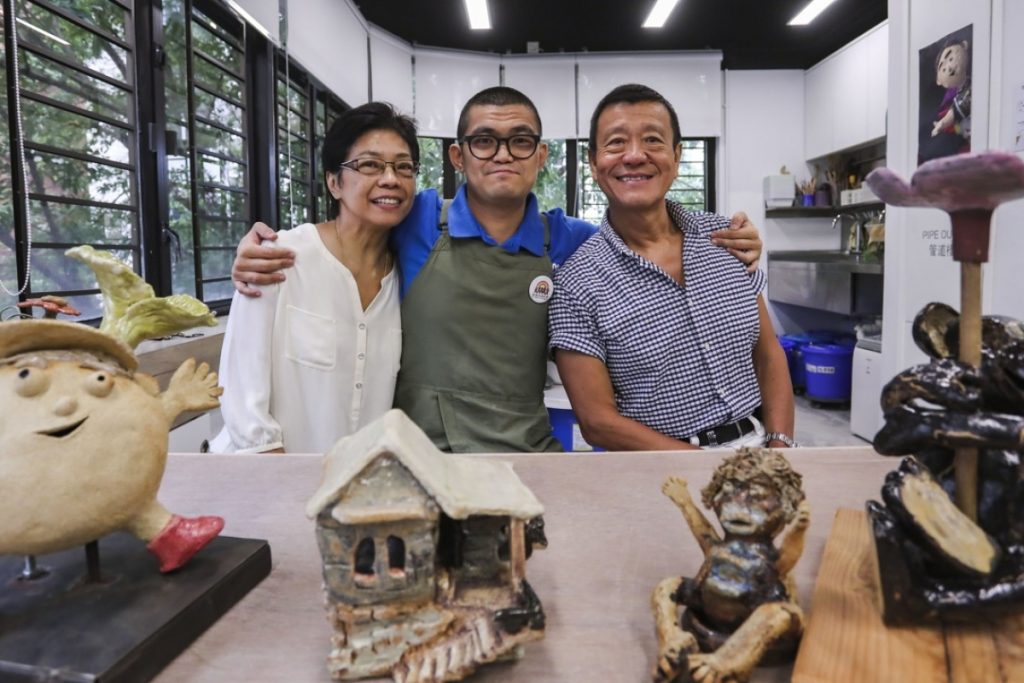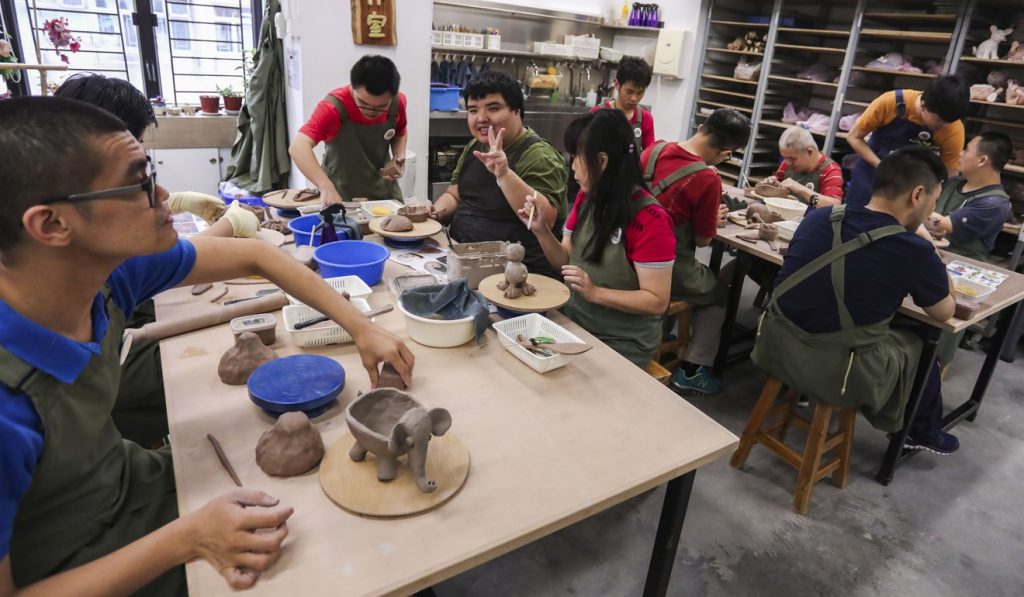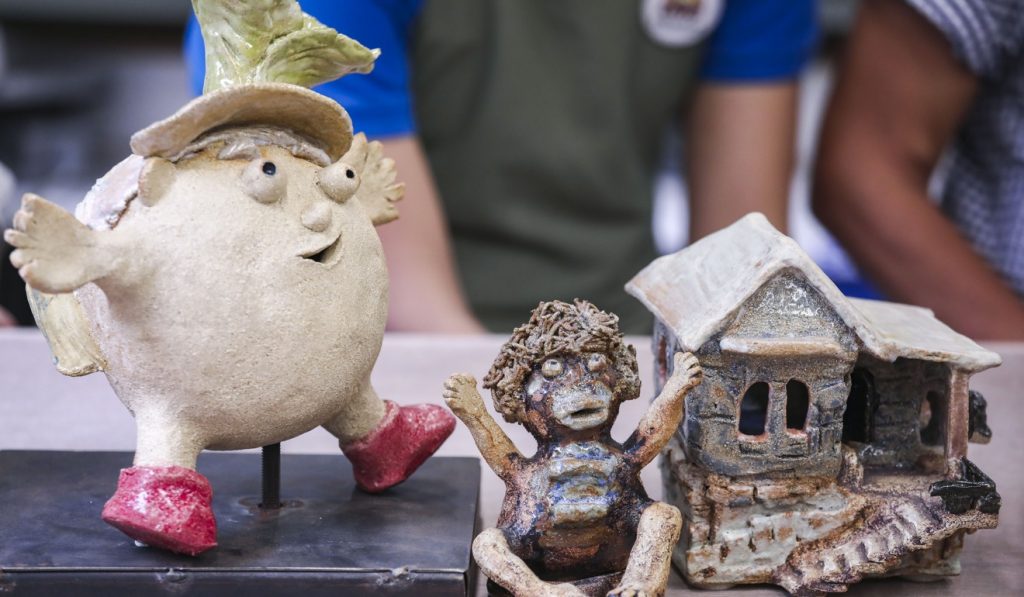How a ceramics class revealed the hidden talent of a special-needs Hongkonger
14 Jul 2018
South China Morning Post / Click here to enter
Once quiet and withdrawn, mentally disabled artist now sees his works displayed at local and international exhibitions

Susan Hui So-shing (left), Gordon Hui Ka-ho and Gilbert Hui Wai-ki at a St James’ Settlement studio in Wan Chai. Photo: Jonathan Wong
Gilbert Hui Wai-ki never realised his 37-year-old son kept childhood memories until the mentally handicapped child made a delicate pottery house featuring a back and front yard surrounded by low fences.
“The design, the structure ... it looks just like the house we used to live in in Canada,” Hui says. “My son must have made it subconsciously.”
His child, Gordon Hui Ka-ho, is one of 30 mentally disabled students enrolled in a ceramics class offered by the non-profit group St James’ Creation, a branch of St James’ Settlement. Since joining the class seven years ago, Hui has made about 100 pieces of clay art, some of which have been displayed at more than 20 local and international exhibitions.
Tang Kar-po, project officer of rehabilitation services at St James’ Creation, recalls Hui showing an affinity for mud and clay from the very first lesson as well as a knack for creativity.

Hui (left) began studying in the class offered by St James’ Creation in 2011. Photo: Jonathan Wong
“It’s hard for all our mentally disabled students to stay focused, but I could see he had the talent for this,” Tang says. “There’s no way he couldn’t make it, so I just waited for him.”
About 71,000 to 101,000 residents in Hong Kong had intellectual disabilities in 2013, accounting for 1 to 1.4 per cent of the total population, according to government data.
Yet the city is witnessing a considerable lack of services catering to this group’s needs.
In 2016, a total of 10,474 positions were provided to the mentally handicapped in day activity centres and sheltered workshops offering training in living and professional skills, a Legislative Council report noted, with more than 4,000 people on a waiting list.
The same report estimated it took a candidate 52 months on average to be accepted into an activity centre – with each receiving a monthly subsidy of HK$10,106 (US$1,280) – and 20 months to get a job in a workshop where HK$5,565 per month would be paid to each employee.

Students in the class have contributed more than 1,000 ceramic works to one of the worlds biggest modern art festivals. Photo: Jonathan Wong
That makes the students in Tang’s class the lucky ones in Hong Kong.
Now visiting the organisation’s ceramics centre three to four days per week, Hui also teaches pottery and porcelain-making workshops that are open to the public.
When the star ceramics student told his parents he was going to teach others, his father was at first sceptical.
“I didn’t even know he had such potential. In fact, I never really knew how to deal with him。”
Gilbert Hui Wai-ki, father of Gordon Hui Ka-ho
“My son is always smiling, but I have no idea what’s on his mind,” he adds.
Susan Hui So-shing, Gordon’s mother, says she has seen gradual changes in her son ever since he started making ceramics.
“He used to be totally quiet and withdrawn. Now he’s more willing to use gestures to communicate with people because he needs to express himself when working on a team.”
For 14 years, he had been employed as a packer at a sheltered workshop before Tang met him in 2011 during an orientation session run by St James’ Creation. Now besides working at the shop, Hui also receives a subsidy for teaching ceramics at St James’ Creation.
For those like Gordon Hui, who can only pronounce one-syllable words, making ceramics can be a way to express what they cannot say in language, his mother says.
“I feel that he has finally entered the real world.”
In two weeks, he will visit Japan with two ceramics classmates to take part in the Echigo-Tsumari Art Field. It is billed as one of the world’s biggest modern art festivals, and 11 of Hui’s works will be exhibited.
Tang’s students are contributing more than 1,000 ceramic art pieces to the festival. Themes for the works include animals and cartoon characters, she adds, and all are decided by students after a vote.
“When we ask them what they prefer to make, we get to understand what they’re thinking,” Tang says.
“We want to bring them into a world of other people and encourage them to look at the society they grew up in.”.
“Making ceramics is my son’s department, just like the way he works in a workshop,” Gilbert Hui says. “He knows exactly which days to go to the pottery centre.”
“He recognises that there is somewhere he can go to. It’s a huge sense of belonging.”
The father clearly remembers their life in Canada before the family moved back to Hong Kong in 1989.
His son Gordon, then just shy of eight years old, used to stay inside their house all the time, peeking through the door hole to wait for his parents to come home.
“Perhaps that’s why he knows the structure of the house so well,” the father says.